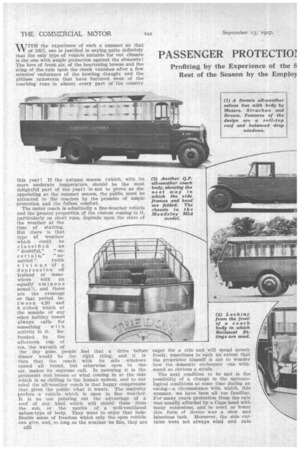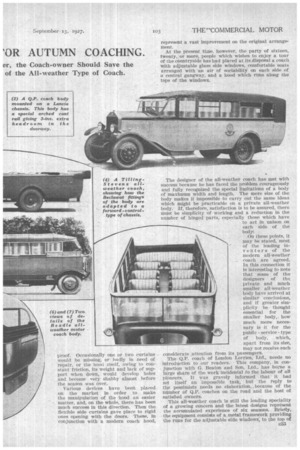PASSENGER PROTECTIOT 'OR AUTUMN COACHING.
Page 54

Page 55

Page 56

If you've noticed an error in this article please click here to report it so we can fix it.
TITH the experience of such a summer as that V of 1927, one is justified in saying quite definitely that the only type of vehicle suitable for our climate is the one with ample protection against the elements! The love of fresh air, of the heartening breeze and the sting of the rain upon the cheek vanishes after a few minutes' endurance of the howling draught and the pitiless rainstorm that have featured most of the coaching runs in almost every part of the country this year! If the autumn season (which, with its more moderate temperature, should be the most delightful part of the year) is not to prove as disappointing as the summer season, the public must be attracted to the coaches by the promise of ample protection and the fullest comfort.
which could be classified as "doubtful," •" un certain," "Un settled" (with visions of a depression off Iceland or somewhere with an equal* ominous sound!), and there are the evenings or that period between 4.30 and 8 o'clock which at the seaside or any other holiday resort always calls for something with
activity in it. Refreshed by the afternoon cup of
tea, the warmth of
the day gone, people feel that a drive before dinner would be the right thing, and it is then that the coach with its side windows raised all round, but otherwise open to the air, makes its supreme call. In motoring it is the persistent cool breeze or wind coming in at the side which is so chilling to the human system, and to our mind the all-weather coach is that happy compromise that gives the public what it wants. The majority prefers a vehicle which is open in fine weather. It is no use pointing out the advantage of a roof of any kind, which will shield them from the sun, or the merits of a well-ventilated saloon-type of body. They want to enjoy that indefinable sense of freedom which only the open vehicle Can give, and, so long as the weather be fine, they are
C32 eager for a ride and will spend money freely, sometimes to such an extent that the proprietor himself is apt to wonder how the domestic exchequer can withstand so obvious a strain.• The next condition to be met is the possibility of a change in the meteorological conditions at some time during an outing—a circumstance with which, this. summer, we have been all too familiar. For many years protection from the rain was usually afforded by a Cape hood with many extensions, and to erect or lower this form of device was a sloW and laborious task. Moreover, the side curtains were not always wind and rain
proof. Occasionally one or two curtains would be missing, or badly M. need of repair, or the hood itself, owing to constant friction, its weight and lack of support when down, would develop holes and become very shabby almost before the season was over.
Various devices have been placed on the market in order to make the manipulation of the hood an easier matter, and, on the whole, there has been much success in this direction. Then the flexible side curtains gave place to rigid ones opening with the doors. These, in conjunction with a modern coach hood,
represent a vast improvement on the original arrangement.
At the present tiMe, however, the party of sixteen, twenty, or more, people which wishes to enjoy a tour of the countryside has had placed at its disposal a coach with adjustable glass Side windows, comfortable seats arranged with an air of sociabi1it3i on each side of a central gangway, and a hood which runs along the tops of the windows.
The designer of the all-weather coach has met with success because he has faced the problem courageously and fully recognized the special limitations of a body of maximum width and length. The mere size of the body makes it impossible to carry out the same ideas which might be practicable on a private all-weather body. If, therefore, satisfaction is to be assured, there must be simplicity of working and a reduction in the Dumber of hinged parts, especially those which have to act in unison on each side of the body'.
On these points, it may he stated, most of the leading inventors of the modern all-weather _ coach are agreed. In this connection it is interesting to note that some of the designers of the private and much smaller all-weather . body have arrived at similar conclusions, and if greater simplicity be thought essential for the smaller body, how much more necessary is it for the public service type of body, which, apart from its size, may not receive such considerate Attention from its passengers.
The Q.P. coach of London Lorries, Ltd, needs no introduction to our readers. This company, in conjunction with G. Beaton and Son, Ltd., has home a large share of the work incidental to the labour of all pioneers. It Was gravely informed that it had set itself an impossible task, but the reply to the pessimists needs no elaboration, . because of the number of Q.P. coaches on the road and the host of satisfied owners.
This all-weather coach is still the leading speciality
of a growing concern and the latest designs represent the accumulated experience of six seasons. Briefly, the equipment consists of a metal framework providing the runs for the adjustable side windows, to the top of
which is attached a metal cant rail which gives a sliding bearing for the stump hoopsticks. The standard fitting is made so that the whole of the side-window framework hinges down with such compactness that it is practically, concealed, giving the open body all the appearance of a large touring car.
The coach can be used as a totally enclosed vehicle with all the windows and hood up, or as a wind and dust-proof coach with any 'desired individual, adjustment of the balanced or mechanically operated windows. ' • Recent patterns include a fixed frame over the front doorway and all the latest features of the smart and fashionable coach, such as a sloping or Yee-shaped screen, a low elbow line, skirt panelling, and the most luxurious of seating arrangements. The equipment is also supplied with a fixed side framework.. The Triumph head and All-weather equipment of Messrs. Bei:tuning Bros. has a sliding hood. The neat metal window frame supports may be folded down, so that the coach is converted into an attractive open pleasure vehicle.
Of particular interest is the all-weather coach equipinput as supplied by Beckett, Laycock and Watkinson, Ltd. The set of Beclawat fittings is a very comprehensive one, for it includes not only the hood and window fittings and complete windscreen, but the chief members of the side framework as well.
The side pillars are of metal and extend from the tops of the windows to the bottom of the body. The feet of these pillars are of bracket shape, so that when bolted to the reinforced cross-bars, they take the place of the ordinary body plate. The pillars are pro vided with the necessary attachments for the longitudinal members of the framework, and the amount of woodwork necessary and the labour entailed in finishing the body are reduced to a minimum. The longitudinal member, or cant rail, which runs along the tops of the windows is fixed so that the window frames are permanent. The balanced Windows are adjusted by mans of the Beclawat monolever lock.
The riding public has little or no objection to these fixed window frames, especially when they are of neat find elegant proportions. • This is not a mere assumption but the result of opinions which have been collected from coach owners in all parts of the country. These permanent side frames may he regarded as the central Idea of the modern all-weather coach.
With the Beclawat equipment the cant rail is extended downwards at the rear, forming two sides of the last side-window and also a runway for the hoed, 1 1 a
SO that the hoopsticks never leave the guide channels which are formed by the cant rail. This is, of course, a feature which facilitates the raising of the hood.
Apart from the merit of the fittings as a medium for constructing an all-weather coach, they are unique in that they represent.a scheme for supplying the bodybuilder with the component parts for building a metal framework. • Another notable example which includes a fixed side framework with adjustable windows and sliding hood
is the all-weather coachwork, of J. Beadle and Co.,
Ltd. The sliding hood of the Beadle coach has been ingeniously designed to ensure easy working. Each end of the hoopsticks terininates in •a bronze ball.
These hall ends slide in a metal tube slotted at the top. A bracket piece is attached on the inner side of the hoopstick at its-lower end. This embraces the cant rail .tuthe and is provided with a thumbscrew. This screw passes through the shoulder of the bracket piece and also a curved plate between it and• the tube. By tightening the setscrew the concave surface of the plate is forced against the convex surface of the tube, and, since the bracket is attached to the hoopstick, its ball-end is pressed tightly against the inside of the tube and held securely.
Another school of thought is represented by the wellknown all-weather coach of Messrs. Strachan and Brown, wherein the roof is made to roll up in sections towards a central longitudinal housing. Each section slides between the hoopsticks and corresponds to the width of each main window. These sections, being only half of the width of the body, are light and easy to manipulate and give scope for varying the top venti ation as required. The contours of the roof are preserved• and the method of construction lends itself to a pleasing interior finish, including inlaid work if desired. Another advantage is that it is easily cleaned. When. closed the sections are locked at the !ant rail. This' roll-top roof all-weather coach has been supplied in increasing numbers for several seasons )ast, Messrs. Strachan and Brown also make an all-weather coach with a fixed metal side framework ad sliding hood.
It will be noted that in the majority of the coaches described there is the same central idea—i.e., a fixed Ide framework with adjustable windows. If further .efinenaents are to be introduced, it would appear to e In the direction of making the folding hood, or moving roof Portion, to work automatically, either by neans of springs, an electric motor. or by gearing from fie engine, which will effect a •similar purpose.












































































































